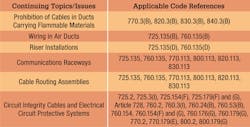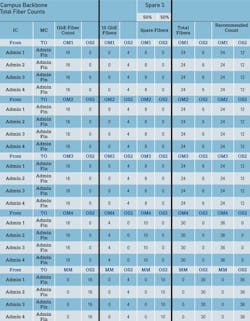From the September, 2013 Issue of Cabling Installation & Maintenance Magazine
Recently made available from the NFPA, the 2014 NEC includes several changes of interest to professionals in the data/comm cabling field.
By Stanley Kaufman, PhD, CableSafe Inc.
The National Electrical Code (NEC) is published by the National Fire Protection Association (NFPA; www.nfpa.org) with revisions on a three-year schedule. The 2014 NEC, which replaces the 2011 NEC, was released by the NFPA in August 2013. (NFPA 70, NFPA, National Fire Protection Association, National Electrical Code, and NEC are registered trademarks of the National Fire Protection Association.)
This article, written on behalf of the Communications Cable and Connectivity Association (CCCA; www.cccassoc.org), is intended to provide the reader with a guide to the key changes in the 2014 NEC that are of interest to manufacturers, installers, distributors and users of data/comm cables.
This article is not intended to be a primer on the NEC. In 2011 and 2012, Cabling Installation & Maintenance published a series of articles, which I also authored on behalf of the CCCA, on the 2011 NEC and the development of the 2014 NEC. These articles provide a great deal of information on the National Electrical Code development process.
Data/comm cables
Although widely used in the industry, the term data/comm cable does not appear in the NEC. The term data/comm cable, as used in this article, encompasses six families of cable types in the NEC.
- Optical fiber cables, Types OFNP, OFCP, OFNR, OFCR, OFN and OFC
- Communications cables, Types CMP, CMR, CMG and CM
- Coaxial cable TV cables, Types CATVP, CATVR and CATV
- Class 2 cables, Types CL2P, CL2R and CL2
- Class 3 cables, Types CL3P, CL3R and CL3
- Power-limited fire alarm cables, Types FPLP, FPLR and FPL
The applications of data/comm cables and their associated equipment are in 11 articles that are the responsibility of three code-making panels.
This article organizes the Code changes into two categories: 1) entirely new topics/issues, 2) continued development.
New topics and issues
Field-assembled optical fiber cables--Not all optical fiber cables are made in a factory; some are assembled in the field by first installing a tube and then blowing fibers into the tube. Article 770 now recognizes field-assembled optical fiber cables.
- The definition of an optical fiber cable has been broadened to include field-assembled cables, and
- Listing requirements have been established for the components (jacket and fibers) of field-assembled optical fiber cables.
Plenum-rated cable ties and cable accessories--NFPA 90A, Standard for the Installation of Air-Conditioning and Ventilation Systems, has requirements for discreet components in a plenum, including cable ties. These requirements have been incorporated into the 2014 NEC, which now requires that nonmetallic cable ties and other nonmetallic cable accessories used to support and secure cables in a plenum are listed as having low smoke- and heat-release properties.
Modular data centers--Article 646, Modular Data Centers, makes its debut in the 2014 NEC. Modular data centers, which are commonly built up of modules housed in shipping containers, are becoming a common way to construct a data center. Article 645, Information Technology Equipment, is a voluntary article, i.e. it is permitted to provide alternate wiring methods to the usual wiring methods. Article 646 is mandatory. It is not voluntary. It applies to modular data centers.
Continuing topics and issues
Prohibition on cables in ducts carrying flammable materials--Section 300.22(A) prohibits the installation of any electrical wiring system in ducts used to transport dust, loose stock or flammable vapors. This requirement only applies to Chapter 8 (Communications), where it is specifically referenced in Chapter 8; see 90.3 Code Arrangement. The 2011 NEC added a reference to 300.22(A) in 800.3 "Other Articles." The 2014 NEC extended this requirement to CATV (Article 820) and network-powered broadband cables (Article 830), and also to conductive optical fiber cables (Articles 770 and 840).
Wiring in air ducts--The 2011 and 2014 NEC restrict the lengths of plenum-grade optical fiber and communications cables in air ducts (fabricated ducts used for environmental air) to a maximum of 4 feet of cable directly associated with the air distribution system. The 2011 NEC retained the long-standing permission [725.154(A) and 760.154(A)] to install unlimited lengths of Class 2, Class 3 and power-limited fire alarm plenum cables in air ducts. The 2014 NEC restricts the lengths of Type CL2P, CL3P and FPLP cables to "lengths as short as practicable to perform the required function."
Riser installations--In the 2008 NEC, riser rated (or plenum) cables were required in vertical runs of more than one floor, but general-purpose cables were permitted for cables penetrating only one floor. Where general-purpose cables were used, they had to be in a separate floor penetration from multi-floor runs of riser and plenum cables. The 2011 NEC simplified this complex situation by requiring riser (or plenum) optical fiber and communications cables even if penetrating only one floor. The 2014 NEC continued this simplification by extending it to Class 2, Class 3 and power-limited fire alarm installations.
Communications raceways--The 2008 edition of the NEC contained listing requirements and applications for signaling raceways (Article 725), optical fiber raceways (Article 770), communications raceways (Article 800) and CATV raceways (Article 820). Each of these families of raceways had general-purpose, riser and plenum grades. The 2011 NEC began the process of consolidating these redundant raceway types by eliminating CATV raceways and replacing them with communications raceways. The 2011 NEC also permitted communications raceways to substitute for optical fiber raceways so that an installer only had to carry two types--signaling and communications raceways.
The process of consolidation is complete in the 2014 NEC. Signaling and optical fiber raceways have been replaced by communications raceways. Communications raceways are now permitted for use with Class 2 and Class 3 cables (Article 725), power-limited fire alarm cables (Article 760), communications cables (Article 800), CATV cables (Article 820) and low-powered network-powered broadband communications cables (Article 830).
The definition of a communications raceway has been revised to reflect its wider applications. It is now defined as follows. Communications Raceway: An enclosed channel of nonmetallic materials designed expressly for holding wires and cables, typically communications wires and cables, optical fiber and data (Class 2 and Class 3), in plenum, riser, and general-purpose applications.
Cable routing assemblies--Cable routing assemblies are widely used in data centers as a support/management system for cables. They were designed for use with optical fiber cables, but they are also used for data (Class 2) and communications cables. The fire tests for listing general-purpose, riser and plenum cable routing assemblies are identical to the fire tests for listing general-purpose, riser and communications raceways. UL 2024, Standard for Signaling, Optical Fiber and Communications Raceways and Cable Routing Assemblies, covers the listing of cable routing assemblies as well as signaling, optical fiber and communications raceways. Applications of general-purpose and riser cable routing assemblies were introduced for use with optical fiber and communications cables in Articles 770, 800, 820 and 830 in the 2011 NEC.
The 2014 NEC has extended the applications of cable routing assemblies to Class 2, Class 3 (Article 725) and power-limited fire alarm cables (Article 760). The 2014 NEC also established listing requirements for plenum cable routing assemblies but restricted their use to riser and general-purpose applications.
The definition of a cable routing assembly has been revised to reflect its wider applications. Cable Routing Assembly: A single channel or connected multiple channels, as well as associated fittings, forming a structural system that is used to support and route communications wires and cables, optical fiber cables, data cables associated with information technology and communications equipment, Class 2 and Class 3 cables, and power-limited fire alarm cables.
The key difference between a raceway and a cable routing assembly is that raceways are enclosed. Cable routing assemblies may or may not be enclosed.
Circuit integrity cables--Circuit integrity data/comm cables are recognized in the 2011 NEC. Article 725 defines a circuit integrity (CI) cable as "Cable(s) used for remote-control, signaling, or power-limited systems that supply critical circuits to ensure survivability for continued circuit operation for a specified time under fire conditions." There are similar definitions in Article 760 for a Fire Alarm Circuit Integrity (CI) Cable and in Article 800 for Communications Circuit Integrity (CI) Cable.
There are two types of circuit integrity cables--those that are not intended to be installed in raceway (or conduit) and those that use raceway as part of the design for achieving survivability. Circuit integrity cables that use raceway for achieving survivability are considered to be part of a "listed electrical circuit protective system."
The 2014 NEC has a new Article, Article 728, Fire Resistive Cable Systems, covering circuit integrity and electrical circuit protective systems. In addition, the provisions of Articles 770 and 800 covering circuit integrity cables have been expanded to include electrical circuit protective systems.
The purpose of this article is to provide a timely overview of the changes in the 2014 NEC that apply to data/comm cables and related raceways and cable routing assemblies. Additional articles are planned.
The 2014 National Electrical Code is available for purchase from the National Fire Protection Association--www.nfpa.org. ::
Stanley Kaufman, Ph.D. is principal of CableSafe Inc. and a consultant to the Communications Cable and Connectivity Association (www.cccassoc.org). He is a member of NEC Code-Making Panels 12 and 16. He is also a member of the NFPA Technical Committee on Electronic Computer Systems, which is responsible for NFPA 75; Kaufman also is a member of the NFPA Technical Committee on Telecommunications, which is responsible for NFPA 76.
This article, contributed by the Communications Cable and Connectivity Association (CCCA), is offered for general information and educational purposes. It is not offered, intended, nor should it be relied upon as legal advice. The article does not set forth the views of any member or any other party, nor may it be taken as such. CCCA makes no warranty regarding the accuracy of the information provided in this article, and expressly disclaims any implied warranties and any liability for use of this paper or reliance on views expressed in it. CCCA does not endorse, approve or certify any information set forth in this article, nor does it guarantee the accuracy, completeness, efficacy, timeliness or correct sequencing of such information. Use of this article and the views expressed in it is voluntary, and reliance on it should only be undertaken after an independent review of its accuracy, completeness, efficacy and timeliness, and based on the individual facts and circumstances of a user.
Archived CIM Issues


